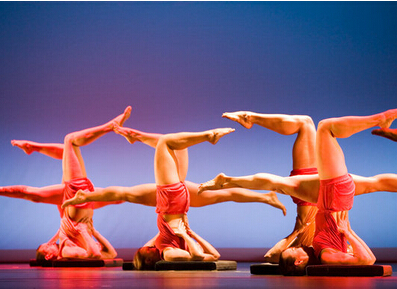This week, the international yoga community said goodbye to a beloved teacher, B.K.S. Iyengar, who died at the age of 95. He is credited with bringing yoga to the Western world and making it accessible to every age and walk of life. To learn more about what makes Iyengar yoga so special to those who practice it, I spoke with Carrie Owerko, a teacher at the Iyengar Yoga Institute of Greater New York. She was also a student of B.K.S. Iyengar, and studied with him in India in February. Here’s an edited version of our conversation.
本周,国际瑜伽界跟深受敬爱的老师B·K·S·艾扬格(B.K.S. Iyengar)告别。他享年95岁。他被认为是把瑜伽带到西方世界的功臣,让所有年龄段和各个阶层的人都能接触到它。为更多地了解艾扬格瑜伽对练习者来说为何如此特别,我采访了大纽约区艾扬格瑜伽协会(Iyengar Yoga Institute of Greater New York)的老师卡丽·奥沃科(Carrie Owerko)。她也是B·K·S·艾扬格的学生,今年2月份跟他在印度学习。下面是我们谈话的剪辑版。
Q. Why was B.K.S. Iyengar such an important teacher?
问:为什么B·K·S·艾扬格是一位重要的老师?

A. B.K.S. Iyengar was really a pioneer. He was one of the people who brought yoga to the West and really made it popular because he made it approachable for anyone. He felt that yoga was for everybody. No matter what the challenges — physical challenges, mental challenges or age — he didn’t see any limitation.
答:B·K·S·艾扬格真的是一位先驱。他是最早把瑜伽带到西方社会的人之一,他让它变得真正流行,让任何人都能接触到它。他觉得瑜伽属于所有人。身体或精神上的缺陷乃至年龄在他看来都不是限制。
I think one of his main contributions was making yoga accessible, but also the degree of attention he gave to the practices of asana, or postural yoga, and to pranayama, the breathing exercises, was immense. He was also an amazing communicator. He was constantly finding new ways to help his students increase their capacity to be aware of what was going on in their bodies and minds.
我觉得他的主要贡献之一是让所有人都能练瑜伽,而且他十分关注瑜伽体位和呼吸。他还非常擅于沟通,不断寻找新方法帮助学生提高了解自己身心的能力。
Iyengar is a lot of the yoga people experience in the United States. The teacher may not be teaching Iyengar, but that teacher has been influenced by Iyengar yoga in some way.
在美国,很多瑜伽练习者都练过艾扬格瑜伽。他们的老师教的可能不是艾扬格瑜伽,但是那位老师在某些方面总会受过艾扬格瑜伽的影响。
Q. What is unique about Iyengar yoga?
问:艾扬格瑜伽的独特之处是什么?
A. What distinguishes Iyengar yoga is the very high degree of attention paid to alignment. Props may be used to increase awareness and to make the poses accessible. Sometimes we hold the poses longer than students might be used to in a flow-style class. There is an emphasis on movement, but then learning how to calmly abide in the body.
答:艾扬格瑜伽的一个特点是非常注重校正。可能会使用道具来增强意识,帮助练习者做出某些姿势。有时我们练习某些姿势的时间比流瑜伽的课程要长一点。我们注重运动,但是然后就要学习如何平静地活在自己的身体里。
The diversity of practice is another distinguishing element. We don’t do one sequence every day. That is the case in other popular types of yoga where there might be a consistent sequence repeated day to day. Even though we do repeat some of the same poses, there is a lot of diversity in the sequencing. In my experience that helps prevent injury and overuse. His approach is therapeutic in nature. That is a huge aspect to the practice.
另一个显著的特点是练习的多样化。我们不是每天都重复一套动作。其他流行的瑜伽派别可能每天重复一套动作。虽然我们确实也重复某些姿势,但是在顺序上有很多变化。根据我的经验,那能帮助防止受伤和劳损。他的方法在本质上是治疗性的。那是这项锻炼很重要的一个方面。
Q. Why did B.K.S. Iyengar use props in his teaching?
问:为什么B·K·S·艾扬格在教学中使用道具?
A. Take the yoga block. Everybody knows a yoga block. It’s something you can get at Bed Bath & Beyond. The prototype of the yoga block was actually a rock or cinder block from B.K.S. Iyengar’s garden. When he was teaching students, he would sometimes place students over his knee for a supported back arch if they couldn’t support themselves. The story goes that he asked his daughter to go in the yard and bring this cinder block to help. That was the beginning of the yoga block. He would use whatever was in the environment — tables, chairs, ropes. The more common props — belts, straps, blocks and chairs, this is the type of equipment that was not really used in the practice of yoga. Now everybody is using them. There are never enough props to go around.
答:以瑜伽砖为例。每个人都知道瑜伽砖,在Bed Bath & Beyond商店就能买到。瑜伽砖的来源实际上是B·K·S·艾扬格花园里的一块石头或煤渣砖。教学生的时候,有时如果学生自己支不起来的话,他会把学生放在自己膝盖上作为背部拱起的支撑。据说他让女儿去院子里找一块煤渣砖帮忙。那就是瑜伽砖的起源。他会利用周围的任何东西——桌子、椅子和绳子。更常见的道具是腰带、带子、砖块和椅子,过去它们并不用于瑜伽练习。如今每个人都在用。道具再多也不嫌多。
Q. Is there a distinguishing pose or style of pose that is unique to Iyengar?
问:艾扬格瑜伽有没有一种独特的姿势或者一种独特的体式风格?
A. I don’t know of a pose that we do exclusively in Iyengar that is not done in other styles. But the headstand and shoulder stand are really important poses in our practice. They are not always taught in other styles of yoga. We have alternatives for people who are not able to do them. If someone comes to an Iyengar class, they know there will be some inverted pose that is taught. We don’t require to people do them but we try to make them accessible and safe. We insist on a yoga blanket to prevent overstretching of the neck area. Iyengar yoga is very cautious and mindful.
答:我没听说有哪种瑜伽体式是艾扬格瑜伽独有的。但是头倒立和肩倒立对我们的练习非常重要。其他类型的瑜伽并不都教这些体式。对那些做不到这些体式的人,我们有一些替代体式。来上艾扬格瑜伽课程的人知道我们会教一些倒立的体式。我们不强求,但是会尽量让学生接触到这些体式,并保证他们的安全。我们坚决要求用瑜伽垫,防止颈部的过度伸长。艾扬格瑜伽非常谨慎小心。
Q. When did you last practice with Mr. Iyengar?
问:你上次跟B·K·S·艾扬格一起练瑜伽是什么时候?
In February of this year, I was in India, and B.K.S. Iyengar was in the practice. Even though his daughter and son and now his granddaughter are teaching the majority of the classes now, he would be in the practice hall every single day correcting people and engaging people. Even at 95 years old, he couldn’t help himself. He had to teach. It was his calling.
答:今年2月我在印度时B·K·S·艾扬格还在教课。虽然现在他女儿、儿子和孙女在教大部分的课程,但是他每天都在练习厅纠正学生,和学生交谈。虽然95岁了,他也闲不住。他必须得教。那是他的使命。
Q. Do you have any special memories of him?
问:你对他有没有什么特殊的记忆?
A. There were several different times where we had exchanges and encounters. He notices everything. One memory that stands out — I hadn’t been to India for a few years. He saw me and said, “Oh, a little bit thin.” I had only lost like three pounds and thought, “How could he possibly notice that?” We were laughing. My mother doesn’t even do that.
答:我们有过几次交流。他什么都能注意到。有一件事让我记忆犹新——我有几年没去印度了。他见到我说,“哦,瘦了一点。”我当时只瘦了大概三磅,心想,“他怎么可能注意到了呢?”我们都大笑起来。连我妈妈都做不到。
Another time when he was in the United States for his book tour, we had done a demonstration of poses at the City Center in New York to celebrate his book tour. He loved the theatrical, and we did this demonstration and he was very enthusiastic.
还有一次,他来美国宣传新书,我们在纽约的市中心剧院(City Center)展示一些瑜伽姿势,庆祝他的新书宣传活动。他喜欢那个剧院,我们做了展示,他非常热心。
I remember when we were at the institute he looked me in the eye and said, “You have to maintain.’’ To someone who doesn’t practice yoga, that might not mean anything, but we had worked so hard. It pushes you to break into new territory and challenge yourself, and after doing that you might back off. But that thing about maintaining the practice, that really stuck. Excellence is what he wanted of us. It’s hard to put into words what you feel for someone who has changed your life.
我记得有一次我们在协会,他凝视着我说,“你必须坚持下去。”对不练瑜伽的人来说,这话可能没什么意义,但是我们练得很辛苦。它推动你进入新的领域,挑战自己,在那之后,你可能想后退。但是,坚持练习这件事,真的让你感觉很困难。他希望我们一直优秀。你很难用语言描述你对于改变你生命的人的感觉。













